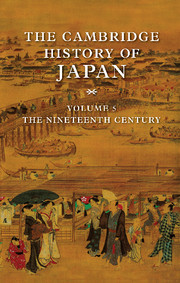Book contents
- Frontmatter
- Introduction
- 1 Japan in the early nineteenth century
- 2 The Tempō crisis
- 3 Late Tokugawa culture and thought
- 4 The foreign threat and the opening of the ports
- 5 The Meiji Restoration
- 6 Opposition movements in early Meiji, 1868–1885
- 7 Japan's turn to the west
- 8 Social change
- 9 Economic change in the nineteenth century
- 10 Meiji political institutions
- 11 Meiji conservatism
- 12 Japan's drive to great-power status
- Works Cited
- Index
- References
4 - The foreign threat and the opening of the ports
Published online by Cambridge University Press: 28 March 2008
- Frontmatter
- Introduction
- 1 Japan in the early nineteenth century
- 2 The Tempō crisis
- 3 Late Tokugawa culture and thought
- 4 The foreign threat and the opening of the ports
- 5 The Meiji Restoration
- 6 Opposition movements in early Meiji, 1868–1885
- 7 Japan's turn to the west
- 8 Social change
- 9 Economic change in the nineteenth century
- 10 Meiji political institutions
- 11 Meiji conservatism
- 12 Japan's drive to great-power status
- Works Cited
- Index
- References
Summary
The second half of the eighteenth century witnessed a new phase of European expansion into the non-European world, stimulated by the mercantilist ambitions of European governments and made possible by a growing technological superiority. One consequence was a series of attempts to develop a profitable trade with the countries of East Asia, most of which, bound loosely together in a political and economic system centering on China, had shown little inclination previously to engage in commerce with other regions. Japan, committed to a policy of national isolation (sakoku) dating from the seventeenth century, gave no sign of responding to such overtures. With China, however, there grew up a trade in tea and silk that by 1800 was of considerable value. In the next fifty years or so, this trade became, first, the main focus of Western economic penetration in East Asia and, then, the raison d'être for a set of institutional relationships, known as the treaty port system, which was eventually extended to most of China's maritime neighbors. As one of those neighbors, Japan became part of it.
The nature of the treaty port system in the nineteenth century derived principally from the commercial policies of Great Britain. These, in turn, reflected a shift from the eighteenth-century doctrines of mercantilism to those of laissez faire, linked with the coming of the Industrial Revolution. In 1840, seeking above all an expanding market for the products of its factories, Britain seized the opportunity afforded by a dispute with China over the opium trade and the treatment of British merchants at Canton to demand the “opening” of China on terms of “equality,” in accordance with the principles of free trade.
- Type
- Chapter
- Information
- The Cambridge History of Japan , pp. 259 - 307Publisher: Cambridge University PressPrint publication year: 1989
References
- 7
- Cited by

